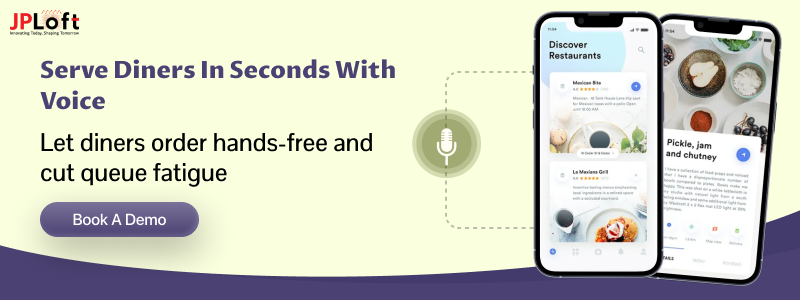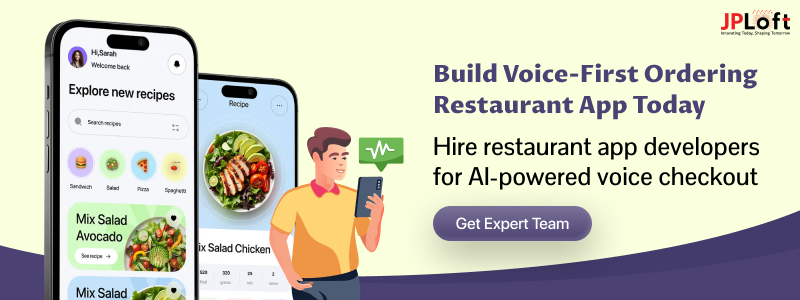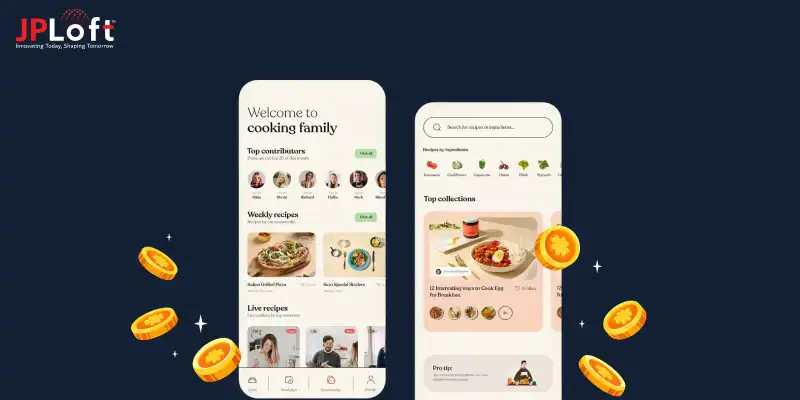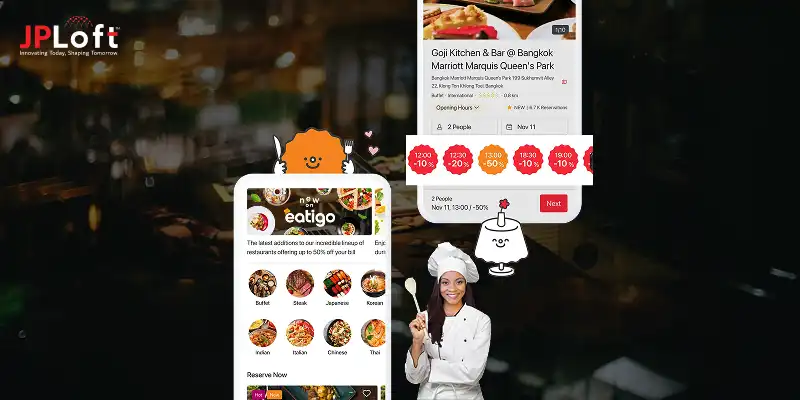"Technology is best when it brings people together."- Matt Mullenweg
In today’s restaurant landscape, bringing people together often starts with a screen and a voice command. From ordering a quick coffee to reserving a five-course dinner, restaurant apps have made dining more convenient, personal, and intelligent.
Now, AI-based voice ordering is taking that convenience to a whole new level. It's not just about tapping a screen anymore; it's about speaking your order and letting AI do the rest.
As artificial intelligence based voice ordering systems in restaurant apps continue to evolve, AI voice ordering for restaurant apps is fast becoming a defining differentiator in the food-tech space.
This blog offers a detailed guide to build a voice ordering system for restaurant apps, examining its benefits, challenges, and implementation costs for 2025.
Key Takeaways:
AI-based voice ordering systems enhance customer convenience and reduce order errors through real-time, hands-free interactions.
To create a voice ordering system, developers must prioritize NLP accuracy, POS integration, and smart UX design.
Understanding the cost to develop a restaurant app involves factoring in AI training, testing, and backend infrastructure.
Data privacy, accent handling, and legacy system compatibility are major challenges in restaurant app development.
Partnering with a trusted mobile app expert like JPLoft ensures scalable voice technology, future-proof integration, and reliable post-launch support.
Restaurant Apps: Growth, Usage, and Why They Matter in 2025
Restaurant apps are no longer just “nice to have”; they’re essential. Whether it’s browsing a digital menu, placing a pickup order, or booking a table, customers now expect everything to happen through a few taps (or increasingly, voice commands) powered by artificial intelligence in restaurant apps.
Here’s what the numbers say:
-
- Over 60% of U.S. diners use restaurant apps regularly for food ordering and reservations.
- The global online food delivery market is forecasted to hit $505 billion by 2030.
- Restaurants that offer app-based loyalty programs see up to 80% higher retention rates.
- Voice-enabled ordering features can improve order speed by 30% and reduce errors by 25%.
- In 2024 alone, the use of AI-based voice ordering systems for restaurant apps rose by over 40% among U.S. restaurants.
“Digital engagement is not just about presence anymore, it’s about personalization, speed, and intuitive design.” - Melissa King, VP, Toast Inc.
For those asking why restaurant apps fail, a lack of innovation, personalization, and poor user experience top the list. The benefits of AI voice ordering in restaurant apps help address these gaps directly.
As restaurants compete for loyalty, apps that offer smart features, like voice search in restaurant apps, can create standout experiences and strengthen user trust in AI voice technology for restaurant apps. For those exploring restaurant app ideas or curious about how to start an online restaurant business, understanding this growth is the first step toward digital transformation.
What Is an AI-Based Voice Ordering App in Restaurants?
An AI-based voice ordering app lets users place food orders simply by speaking. Instead of tapping through menus, they can say, “I’d like a Margherita pizza with extra cheese,” and the app, powered by voice recognition and AI, processes the request instantly. It’s like having a smart assistant inside your restaurant app.
This technology relies on Natural Language Processing (NLP) and machine learning to understand accents, preferences, and even past behavior. It makes ordering faster, more human, and entirely hands-free.
As artificial intelligence in restaurant apps matures, integrating Voice AI in restaurant apps is becoming a core differentiator and acts as a guide to voice ordering for restaurant apps in a competitive landscape.
For brands exploring how to develop a restaurant app, incorporating AI voice tech early can set your product apart from the competition. And if you're evaluating the cost to develop a restaurant app, remember that adding voice capabilities may raise your initial investment, but it also significantly boosts ROI.
If you’re planning to integrate voice ordering systems for restaurant apps, doing so now ensures future readiness and higher user satisfaction.
To implement AI voice ordering for restaurant apps successfully, developers must understand that the role of AI voice ordering systems in restaurant apps isn’t just about automating tasks; it’s about transforming the entire ordering experience.
Why Is Voice Ordering a Game-Changer in Restaurant Apps?
Voice ordering is redefining what convenience means in the dining world.
With just a few spoken words, customers can place complex orders, ask for customizations, or reorder their favourites with no hands, no hassle.
For restaurants, it’s not just a cool feature; it’s a revenue-booster and loyalty driver driven by artificial intelligence based voice ordering systems in restaurant apps.
“Customers now expect restaurant tech to be as smart and seamless as their smartphones. Voice is the next leap.” - Jason Baas, VP of Product, Olo
Here’s why voice ordering is turning heads in the restaurant tech world:
1. Faster and Hands-Free Ordering
Voice commands dramatically speed up order time, especially in voice enabled systems in restaurant apps, where users don’t need to scroll through menus.
2. Enhanced Personalization with AI
These systems remember past orders, preferences, and restrictions, showcasing the benefits of AI voice ordering in restaurant apps through smarter recommendations.
3. Accessibility for All
Voice ordering supports customers with visual impairments or motor challenges, allowing AI voice ordering for restaurant apps to open new demographics.
4. Increased Order Accuracy
By reducing manual input, voice ordering minimises mistakes, especially when integrating Voice AI in restaurant apps designed around conversational prompts.
5. Higher Customer Engagement
With voice, the interaction feels more human, boosting loyalty and reinforcing the role of AI voice ordering systems in restaurant apps as a long-term differentiator.
This is why businesses exploring what defines the best restaurant app are increasingly prioritizing voice tech. It’s also reshaping how restaurant apps make money, with intelligent upselling based on user context.
In fact, as digital ordering gains momentum, solutions like voice-powered AI are making the cost to build a restaurant reservation app like OpenTable a smart long-term investment rather than just a tech trend.
How Does AI Voice Ordering Work in Restaurant Apps?
AI voice ordering might feel like magic, but it’s powered by some seriously smart tech under the hood.
Here’s how your spoken order turns into a neatly placed transaction, showcasing just how effective voice ordering systems in restaurant apps can be when built with scalable AI voice technology for restaurant apps:
1. Voice Recognition
The app listens using built-in voice technology (often powered by tools like Google Speech-to-Text or custom AI models). It captures and transcribes the user's spoken words instantly.
2. Natural Language Processing (NLP)
Once the voice is converted to text, NLP comes in. It breaks down the sentence, “I want a large pepperoni pizza, no cheese”, into structured data that the app understands.
3. AI Interpretation
AI contextualizes the input by detecting food items, sizes, modifiers, and personal preferences. This is crucial if you want to implement AI voice ordering for restaurant apps that handle real-world complexity.
4. Smart Confirmation
Before placing the order, the app confirms details with the user. If needed, it asks follow-up questions (e.g., “Would you like extra sauce with that?”).
5. Order Processing
The order is sent to the kitchen or POS system just like a traditional digital request. That’s the power behind modern voice enabled systems in restaurant apps, where staff intervention drops and operational speed increases.
“We’re seeing AI voice interfaces shift from novelty to necessity in food service.” - Emily Baker, Analyst at ABI Research
This fusion of AI in restaurant apps and smart voice interfaces is setting a new benchmark. As personalization deepens, the system even learns your go-to items and preferences.
And if you're wondering what powers all this innovation, understanding your mobile app tech stack is crucial. From APIs to cloud-based AI services, having the right foundation makes all the difference.
Must-Have Features in an AI-Powered Voice Ordering Restaurant App
To stand out in today’s hyper-competitive food tech space, your AI-powered restaurant app needs more than just voice input. It needs intelligence, personalization, and a smooth user experience from start to finish.
This section also acts as a practical guide to voice ordering for restaurant apps, especially for founders planning long-term scalability.
Here are the essential features you should build into your app:
1] Smart Voice Recognition & NLP Engine
This is the heart of the system. It allows users to speak naturally and have their orders understood without needing to adapt their speech. It uses AI-based voice recognition and NLP to extract items, modifiers, and intent from user input.
2] Real-Time Order Confirmation
Before placing the order, the app should confirm what it heard. This ensures accuracy and lets users correct anything before it reaches the kitchen.
3] Personalized Recommendations
Based on previous orders, time of day, and user behavior, the app can suggest meals using AI-based voice search in restaurant apps. It’s a subtle way to increase order value and improve user satisfaction.
4] Integration with POS and Delivery Systems
Your app should communicate with kitchen printers, POS systems, and delivery modules in real-time. This seamless backend integration is what differentiates top platforms. If you’re analyzing top restaurant app features, real-time syncing ranks high on the list.
As you connect AI voice flows to real-world communications, remember the telephony layer. Many restaurants rely on virtual phone systems for order hotlines, SMS updates, and shared numbers across locations. For a current comparison tailored to business use cases, see Google Voice alternatives options like Quo (OpenPhone) offer shared inboxes, automation, and integrations that pair well with voice ordering and POS systems.
5] Multilingual Support & Accessibility
Support for multiple languages and accessibility features (like speech playback and text support) makes your app more inclusive and broadens your audience base.
6] Interactive UI + Voice Combo
Some users prefer a blend of touch and talk. Pairing voice input with a clean, intuitive interface ensures the best of both worlds and helps align with modern mobile app design principles.
“Restaurants must balance user experience with operational ease, voice does both when done right.” - Anjali Patel, Head of UX at Square
Remember, these features will evolve as AI does. That’s why ongoing innovation is crucial for restaurants looking to stay competitive. If you’re building from scratch or auditing an existing app, our restaurant app design guide can help you prioritize both aesthetics and usability.
Steps to Create a Voice Ordering System in Restaurant Apps
Voice is not the future; it’s the expectation.” - Chris Anderson, CTO at QSR Automation (via Restaurant Technology News)
Creating an AI-based voice ordering system might sound complex, but it becomes highly manageable with the right roadmap. Here are the steps to create a voice ordering systems in restaurant apps, which you can approach strategically:
Step 1: Define Your Use Case & Target Market
Start by identifying who you're building for: fast food chains, cloud kitchens, or dine-in restaurants. This helps shape the voice flow, tone, and menu logic. If you’re exploring how to build an app like TheFork, user expectations from that platform can influence your approach.
Step 2: Choose the Right AI Stack
Select technologies that support Natural Language Processing (NLP), voice recognition, and real-time learning. Google Dialogflow, Amazon Lex, and custom-trained models are strong options. Many businesses hire app developers at this stage to avoid future integration issues and shorten development cycles.
Step 3: Design Conversational UI/UX
Voice interfaces are different from screens. Your interface should pair visual confirmations with fluid voice prompts. Take inspiration from successful platforms or consult a restaurant app maintenance guide to align UX with evolving voice-first behavior.
Step 4: Develop the Voice Engine
Build and train the voice system using datasets from the food and hospitality sector. Include scenarios like order customizations, reorders, and menu browsing.
Step 5: Integrate the Backend
Link your voice engine to your POS system, kitchen printers, delivery platforms, and user profile database. This is critical for real-time performance and personalization.
Step 6: Test, Optimize, and Scale
Start with a pilot in one restaurant location. Use voice analytics to understand drop-offs and optimize. Once refined, scale across locations. This step is crucial if you're following this guide to build a voice ordering system for restaurant apps.
For long-term success and smooth upgrades, consider this mobile app maintenance guide instructing the best possible way to maintain your restaurant app, incorporating AI-based voice ordering systems.
Top Real-World Examples of AI Voice Ordering in Restaurant Apps
Leading restaurant brands are already leveraging AI voice technology to enhance customer experience and streamline ordering.
These powerful case studies highlight how real-world adoption is driving higher engagement, faster operations, and long-term loyalty.
1. Domino’s: Voice Ordering via Dom (AI Assistant)
Domino’s was one of the earliest adopters of voice-enabled ordering, integrating its AI voice assistant "Dom" into both its mobile app and phone ordering system. Customers can speak their orders conversationally, including custom pizzas, in real time.
This helped Domino’s increase repeat orders and retain users who enjoy a hands-free experience. The success of Dom showcases how AI voice technology doesn’t just improve convenience; it can become a unique brand differentiator.
2. Starbucks: Voice Ordering through My Starbucks Barista
Starbucks introduced its AI-powered voice assistant, My Starbucks Barista, inside its rewards app.
Customers can say things like “Order my usual latte” or “I want a grande iced caramel macchiato”, while the app confirms and places the order seamlessly.
This personalized voice experience, tied to the customer’s history, helped drive app engagement and boosted the adoption of Starbucks’ mobile ordering platform, especially among busy, on-the-go users.
3. McDonald’s: Drive-Thru Voice AI (Apprentice Acquisition)
McDonald’s acquired AI startup Apprente to power automated voice ordering at its drive-thru outlets.
The system takes customer orders via voice, confirms them, and directly pushes information to the kitchen display.
Early pilots showed reduced wait times, improved order accuracy, and better throughput during peak hours. McDonald’s investment proves how voice AI can handle high volumes, making it a powerful tool for scaling across global franchises.
How Much Does It Cost to Develop an AI Voice Ordering Restaurant App?
"The ROI on AI in the restaurant space isn’t theoretical anymore; it’s measurable." - Sridhar Ramaswamy, CEO of Snowflake AI, in TechCrunch (2024)
The cost to develop an AI voice ordering app depends on several variables: features, tech stack, integrations, and development team expertise. But to give you a realistic idea, let’s break it down:
Key Cost Factors:
► Voice Recognition & NLP Integration
Expect to spend around $8,000–$20,000, depending on whether you use third-party APIs (like Dialogflow) or build a custom AI model. More advanced personalization features increase the cost.
► Custom App Development (Frontend + Backend)
A fully functional iOS/Android app with voice capabilities may range from $25,000 to $60,000. This includes menu navigation, order processing, voice commands, and admin dashboard.
► Database, Hosting & Real-time APIs
These backend services can cost $4,000–$10,000, especially when connecting to POS systems or third-party delivery services. Here, your mobile app maintenance services play a critical role in optimizing both performance and long-term operational costs.
► UI/UX Design for Voice + Visual Experience
Designing a frictionless experience where users can switch between voice and touch is key. Good insights from restaurant app development challenges suggest budgeting $5,000–$15,000 to ensure the interface supports both voice and visual ordering seamlessly.
► Testing & Deployment
Comprehensive testing is essential. Depending on app complexity, this could range from $2,000 to $7,000. Learn more in our mobile app testing insights to ensure your app doesn’t just work, it excels.
► Total Estimated Cost:
-
MVP / Prototype: $30,000 – $45,000
-
Full-Feature App: $60,000 – $100,000+
-
Enterprise-Grade System: $120,000 and up
Pro Tip: If you're looking to optimize costs, start with a feature-limited MVP, gather user feedback, and iterate.
Top Challenges in Integrating Voice Ordering Systems for Restaurant Apps
"AI is only as good as the data it’s trained on, especially in high-stakes environments like food service." - Fei-Fei Li, Co-Director, Stanford HAI
While AI-powered voice ordering is revolutionizing how customers interact with restaurant apps, the integration isn’t always smooth sailing.
Here are some key challenges developers and restaurant owners must address:
A] Natural Language Understanding (NLU) Complexity
Customers might say, “I want a spicy chicken wrap with no mayo,” or just, “Chicken wrap, spicy.” Designing a system that understands varied accents, phrasing, and slang requires robust AI-based voice search in restaurant apps and constant training of models. It’s not a one-time setup; it evolves with usage.
B] Real-Time Menu Synchronization
Voice ordering systems need to access live menus, availability, and pricing updates. Failing to sync with POS systems or kitchen inventory in real time can result in incorrect orders and poor UX. This makes restaurant app development challenges more complex, especially at scale.
C] Multi-Intent Processing
A customer might say, “Add two cheeseburgers and cancel the fries.” Handling such multiple, dynamic intents within a single voice command takes careful planning. You'll need custom NLP workflows and rigorous testing, as covered in our restaurant app testing guide.
D] Data Privacy & Security Regulations
Voice data, especially if stored or analyzed, must comply with regional privacy laws like GDPR or CCPA. This adds another layer of complexity during integration, especially if your app supports international ordering.
E] Integration with Legacy Systems
Many restaurants still use outdated POS or kitchen management systems. Integrating modern AI voice systems with such infrastructure often requires custom APIs or middleware, adding to development time and cost. This is where choosing an experienced AI app development company becomes crucial.
There are several top mobile app development companies in the USA, which prioritize system compatibility and scalable architecture when building AI-driven restaurant apps.
Future of AI-Based Voice Ordering Systems in Restaurant Apps
"By 2026, over 50% of restaurant interactions will involve some form of AI assistance, with voice emerging as the most frictionless interface." - Accenture Industry Report, 2024
The future of AI voice ordering for restaurant apps is smart and dynamic and set to reshape how users interact with digital menus. As voice technology evolves, here’s what developers and restaurant brands should watch for:
1. Hyper-Personalized Voice Interactions
AI-driven voice systems will adapt to user preferences, remembering frequent orders and suggesting items based on time, mood, or even weather. That level of personalization is where the future of AI voice ordering for restaurant apps truly shines.
2. Cross-Platform Smart Device Integration
Ordering via Apple Watch, Alexa, or even smart car dashboards will become common. This omnichannel evolution not only boosts accessibility but also makes it essential to create an app that supports voice-first UX design across platforms.
3. Predictive Ordering through AI & Machine Learning
Using machine learning, AI will predict a customer’s next order based on history and behavior patterns, improving speed and reducing friction. Developers building these systems must also consider restaurant app development trends to ensure modern, future-ready solutions.
4. Voice-Enabled Operations in the Kitchen
AI won’t just help customers. Staff will use voice assistants for tasks like inventory checks, reporting, and kitchen coordination, making voice tech a back-end asset as well.
5. Multilingual Voice Commands for Global Reach
As the market becomes more inclusive, support for regional languages and dialects will be vital. Whether you’re planning to build an AI app for urban hubs or rural pockets, multilingual voice capabilities will give you a major edge.
"The voice AI market in foodtech is projected to surpass $2.5 billion by 2027, driven by consumer demand for hands-free convenience." - Statista, 2025
Partner with a Leading Restaurant App Development Company
Ready to turn your AI voice ordering vision into a fully functional, user-friendly restaurant app?
At JPLoft, we specialize in building intelligent, scalable, and intuitive digital solutions tailored for the F&B industry. Whether you're running a single outlet or scaling a franchise, our team delivers apps that combine great design, seamless performance, and next-gen AI features.
From voice search to multilingual support and backend integration, we’ve got you covered. Let’s build something game-changing together.
Connect with the top restaurant app development company and get started today!
Conclusion
From streamlining food orders to offering a personalized dining experience, the use of AI-based voice ordering systems for restaurant apps is redefining what’s possible in restaurant apps. They don’t just enhance convenience; they reshape customer expectations and elevate operational efficiency.
Whether you're a restaurant owner, tech entrepreneur, or product strategist, investing in AI voice technology today means staying competitive tomorrow. And as AI continues to evolve, so will the way your customers interact with your app.
FAQs
AI-based voice ordering systems streamline food ordering by allowing users to place orders hands-free using natural language. They enhance user convenience, reduce wait times, and improve overall customer satisfaction.
Voice search in restaurant apps makes ordering more intuitive and accessible, especially for multitasking users or those with disabilities. It speeds up navigation and minimizes manual input errors.
While large chains benefit from scale, AI voice ordering is increasingly accessible to small restaurants too. With scalable APIs and customizable platforms, even small businesses can implement it cost-effectively.
Modern AI voice ordering systems use encryption, biometric authentication, and secure API protocols to protect user data and transaction details.
The future of AI voice ordering for restaurant apps includes features like multilingual support, emotion recognition, predictive ordering, and deep personalization through machine learning.













Share this blog